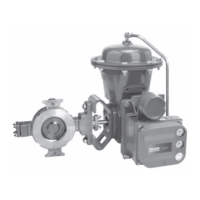8580 Valve
Instruction Manual
March 2010
10
WARNING
Do not lubricate parts when used in
oxygen service, or where the
lubrication is incompatible with the
process media. Any
use of lubricant
can lead to the sudden explosion of
media due to the oil/oxygen mixture,
causing personal injury or property
damage.
6. Use the appropriate procedures below for
installing packing.
D Install the packing as shown in figure 4.
D With graphite ribbon packing, stack the
packing rings and packing washers together,
and slide the stack into the packing box as far
as it will go while carefully avoiding trapping air
between the rings.
D Install the anti-blowout ring (key 40) in the
groove on the drive shaft (key 10).
D Install the packing follower and, if used, the
packing flange.
D Install the packing flange nuts, and tighten
them only far enough to stop leakage under normal
operating conditions.
D For oxygen service applications, attach the
bonding strap assembly (key 131, figure 3) to the
shaft with the clamp (key 130, figure 3), and connect
the other end of the bonding strap assembly to the
valve body with a cap screw (key 35). Secure each
cap screw with a hex nut (key 36).
7. Mount the actuator and adjust the closed position
of the valve, per the Actuator Mounting section on
page 15 of this manual, before returning the valve to
service.
8. When placing the control valve into operation,
check around the packing follower for leakage;
retighten the packing flange nuts as required
according to accepted bolting procedures.
For valves with ENVIRO-SEAL packing systems:
1. Isolate the control valve from the line pressure,
release pressure from both sides of the valve body,
and drain the process media from both sides of the
valve. If using a power actuator, also shutoff all
pressure lines to the power actuator, release all
pressure from the actuator. Use lock-out procedures
to be sure that the above measures stay in effect
while you work on the equipment.
CAUTION
When removing the actuator, use a
wheel puller to separate the actuator
parts from the valve shaft. Do not drive
the actuator parts off the valve shaft
because this could damage valve trim
components.
2. Remove the actuator per instructions in separate
actuator instruction manuals, then remove the cap
screws and nuts (keys 35 and 36). Remove the
clamp (key 130, figure 3) if the strap (key 131,
figure 3) is used.
3. Loosen the two packing hex nuts evenly to
remove spring tension, then remove the nuts.
4. Remove the packing flange and spring pack
assembly. The spring pack assembly consists of the
spring stack and packing follower. The spring stack
is retained on the packing follower by an O-ring.
Remove the anti-blowout ring (key 40) from the
driveshaft (key 10). Remove the anti-extrusion
washer, the packing set, and the packing ring.
CAUTION
The valve shaft surface condition is
critical in making and maintaining a
good seal. If the valve shaft surface is
scratched, nicked, dented, or worn,
replace the valve shaft before
replacing the packing system.
5. Inspect the existing valve shaft. If necessary,
replace the valve shaft as described in the Replacing
the Disk, Shafts, or Bearings section.
6. Install the new packing system components as
described in the ENVIRO-SEAL Packing System for
Rotary Valves Instruction Manual (D101643X012).
7. Install the anti-blowout ring (key 40) onto the
drive shaft (key 10) before installing the packing
follower.
8. Mount the actuator and adjust the closed position
of the valve, per the Actuator Mounting section on

